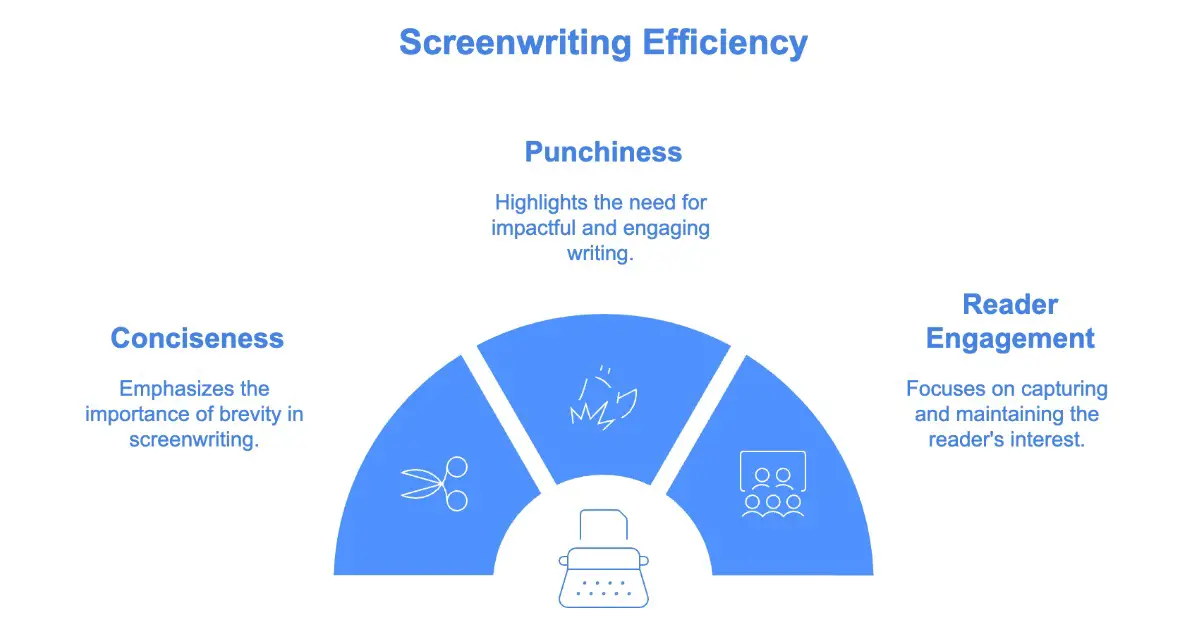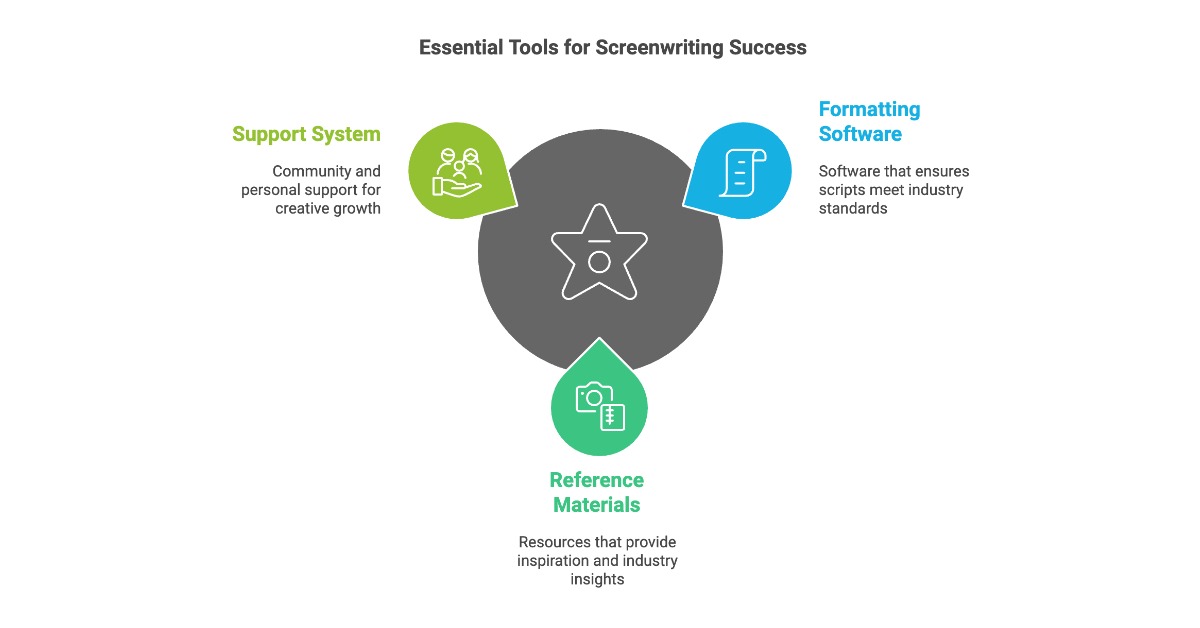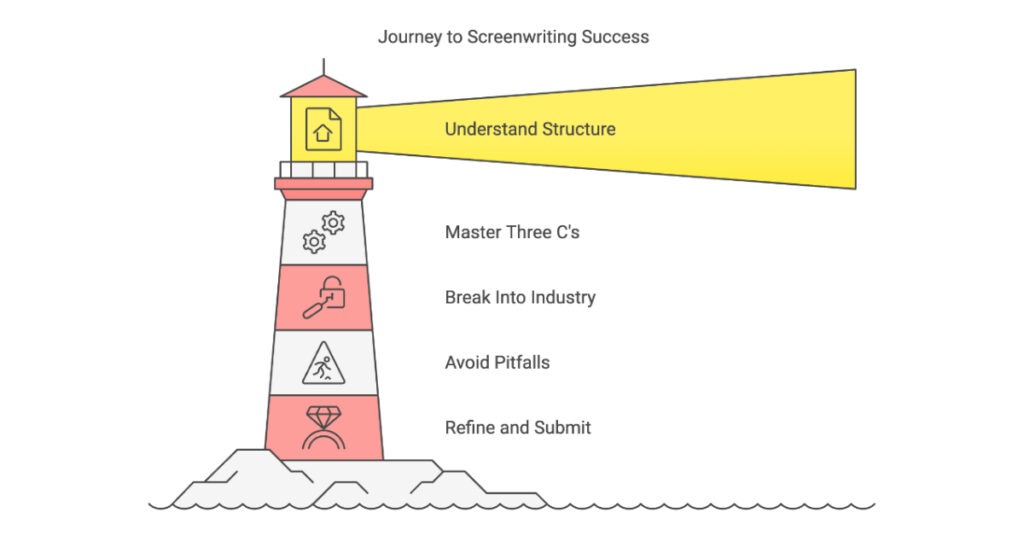Picture this: You’re sitting in a dimly lit theater, completely lost in a world that someone – some writer – crafted from nothing but words on a page. That’s the magic of screenwriting, and I’m here to tell you that yes, you can be that someone. Let’s dive into the essentials that transform blank pages into silver screen magic.
The Golden Rules of Screenwriting: Your Foundation for Success
Remember the first time you tried to assemble IKEA furniture without instructions? Yeah, screenwriting without understanding the fundamentals of story structure is kind of like that – frustrating and likely to fall apart in Act Three. But don’t worry, I’ve got your back.
The Sacred Three-Line Rule
You know how they say good things come in threes? In screenwriting, it’s more like “keep it to three lines – or else.” Here’s why: Screenplay pages are valuable real estate, and every line needs to earn its place. Think of it as the Twitter of creative writing – concise, punchy, and leaving your reader wanting more. For a deep dive into the technical aspects, check out our guide to screenplay formatting essentials.

Structure: Your Story’s Backbone
If you’ve ever wondered why certain movies just work, while others feel like a playlist on shuffle, it usually comes down to structure. Whether you’re working with traditional linear storytelling or experimenting with nonlinear narratives, the classic four-act structure isn’t just some dusty rule – it’s your story’s best friend.
Here’s how it breaks down:
| Act | Purpose | Approximate Page Count |
|---|---|---|
| Act 1 | Setup & Hook | 1-30 pages |
| Act 2A | Rising Action | 30-60 pages |
| Act 2B | Complications | 60-90 pages |
| Act 3 | Resolution | 90-120 pages |
The Three C’s of Screenwriting
“If there’s one thing I’ve learned after years in this business,” a veteran screenwriter once told me while nursing a cold brew at a Writers Guild mixer, “it’s that great scripts nail the Three C’s: Character, Conflict, and Crescendo.”
- Character: Your protagonists shouldn’t just exist – they should feel as real as your slightly eccentric neighbor who collects vintage typewriters. Learn more about crafting memorable characters that leap off the page.
- Conflict: Without conflict, you’ve got a home movie, not a screenplay. Every scene should either create conflict or resolve it – preferably both. Master the art of creating compelling conflict in your scenes.
- Crescendo: Think of your story like a great DJ set – you’re building towards something bigger, better, more meaningful. Each scene should raise the stakes until your climax hits like a bass drop at Coachella. Understanding theme and subtext is crucial for nailing this progression.
Breaking Into the Business: The Real Talk
Let’s have an honest conversation about what it takes to make it in this industry. According to recent data from the Writers Guild of America, breaking in isn’t impossible, but it requires more than just a MacBook and a dream. Learning how to pitch your screenplay effectively is just as important as writing it.
The Cold, Hard Numbers
- Average first screenplay sale: $85,000-$105,000
- Percentage of spec scripts that get produced: < 1%
- Number of rewrites before a script is “ready”: 7-10
But here’s the thing – these numbers shouldn’t discourage you. They should prepare you. Every produced screenwriter started exactly where you are right now.
Essential Tools of the Trade
Think of these as your screenwriting utility belt. Check out our comprehensive guide to screenwriting software and tools for detailed reviews and recommendations:
- Professional Formatting Software
- Final Draft
- WriterDuet
- Fade In
- Reference Materials
- Scripts of films in your genre
- BBC Writers Room Resources
- Industry newsletters
- Support System
- Writing groups
- Online communities
- A good therapist (only half-joking)

Common Pitfalls and How to Avoid Them
I’ve read hundreds of first scripts, and let me tell you – some mistakes are as common as coffee cups in a writers’ room. Here’s what to watch out for:
❌ Starting with a wake-up scene (learn more about writing strong openings)
❌ Excessive camera directions
❌ On-the-nose dialogue (master the art of writing natural dialogue)
❌ Unfilmable descriptions
Instead, focus on:
✅ Opening with a hook
✅ Writing visually
✅ Subtext in dialogue
✅ Actionable descriptions
The Path Forward
The journey from blank page to “FADE OUT” isn’t just about following rules – it’s about finding your voice while speaking the language of cinema. Whether you’re writing for television or film, the fundamentals remain crucial.
Once you’ve completed your script, consider submitting it to screenplay competitions or seeking professional feedback to refine your work. If you’re adapting existing material, be sure to check out our guide on writing successful adaptations.
Ready to start your screenwriting journey? Check out these free resources for screenwriters and dive into the basics of script writing.
Remember, in the words of William Goldman, “Nobody knows anything.” So write your heart out, follow these essentials, and who knows? Maybe I’ll be watching your story on the big screen next year.
Want to learn more about screenwriting? Drop a comment below or join our newsletter for weekly writing tips and industry insights.
